Creating World Wide Woman
I was so carried away by my last Gold Label show that I have decided to describe in some detail how a collection is formed.
I don’t want to use this website to promote my fashion. It is supposed to be about ideas and how we can save the world and also have a better life – Get a Life! But I think it’s a good idea to include my ideas about fashion every now and again. So, to begin…
World Wide Woman (If you would like to know more about the name of this collection, read the press release in ‘The Latest’).
Sometimes I do know the idea for a collection but this time I started really late with no idea except for a fragment of precious ribbon I had seen pictured in an old sales catalogue I discovered among my books. I wanted to get a copy woven, a ribbon I could cut up into same size pieces and sew on to t-shirts instead of graphics. I thought I’d love to wear a bit of old fabric instead of a slogan for a change. The original was mediaeval and the design had such a feeling of that time, formalized eagles in silk and gold threads circumscribed within an undulating chain motif.
All our production is in Italy (all prototypes, however, are done in our Battersea studio). I asked them to find a ribbon factory. Now I had to choose fabrics which he and others had pre-selected from the fabric fair. The less fabric the better, I think, too many and the possible permutations become endless as the ideas gather. And I like to ‘cook’ with basic ingredients. I kept to basic fabrics; some I let in the natural colour of the fiber and as it comes from the loom. I love our toiles, our prototypes which we make in the natural calico before we decide the final fabric; it’s as if the garment epitomizes the first idea of itself.

left: Shirt in cotton natural – state, torn edges – no hems. right: Basic fabric – grey stretch wool flannel dress developed from idea of wearing a cushion cover
For other plain fabrics I stuck to black, grey, indigo, brown, flesh, cream, white. Set against the fabrics we took gold, a lame looking like metal – gold sequins.
I took a very conservative man’s tailoring fabric (I love conservative fabrics – they have so many ideas to play with), a fresco in grey chalk stripe, and made a suit comprising a jacket from two years back and a favourite skirt – the ‘alien’ skirt – World’s End customers will know this skirt. We didn’t sell the jacket at the time because it has a lot of volume around the shoulder (Masculine? But cross dressing is as old as the hills.) and over the breast – but I adore it because it makes a woman look important and there is nothing more sexy than that. I shall wear this suit.
Next autumn it should go into our archive but it will come home with me instead. One thing I knew about the collection – I wanted the woman to look important.
Plain fabrics show off the cut of clothes. I like to mix garments from different times and places: historical, ethnic, 20th century couture – I copied a coat from Balenciaga and a dress from Chanel. I sometimes copy from myself, re-doing clothes from way back in my archive. I like new things as well as things repeated and developed from last season. Most of all, I like ‘do it yourself’, as if the wearer has spontaneously put her own creation together in an afternoon.
I introduced colour by printing. Until recently printing was done only on screens or rollers but now we also have digital printing. The cost of full colour is less because it is all done in one go. There is no setting-up cost so you might as well have every print different. That’s what I did and found every print in my small booklet of fabrics from the Museum of Fine Arts, Boston.
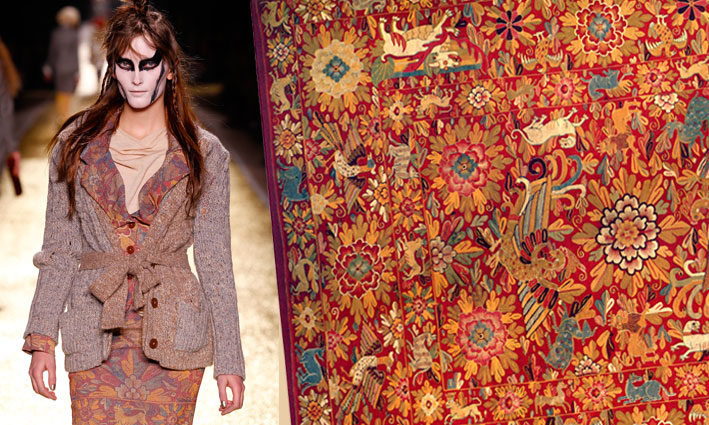
left: Cardigan worn over tiny suit in stretch dress wool, fine knitwear. right: Colonial Peruvian tapestry weaving, 1675-1750
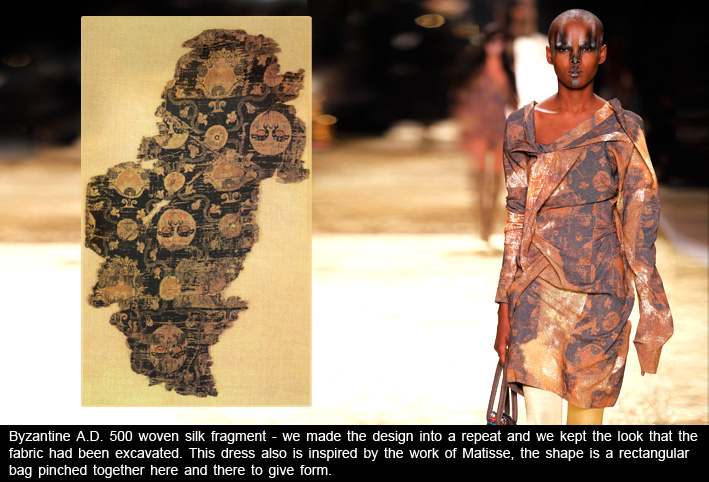
Woven silk fragment
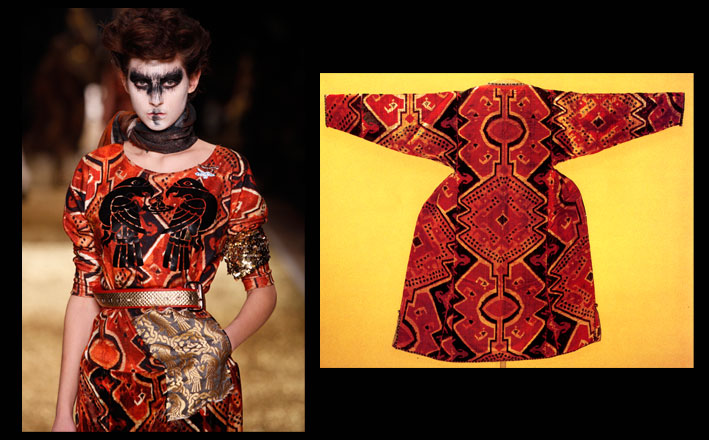
left: Interlock and velvet printed dress right: Woman’s coat (chalat), Westwrn Turkestan, 1800-1900, Silk velvet ikat
Then I chose three yarns for knitwear which we had used for ‘Man’ – ordering more quantity keeps the price down and because the men’s collection
is in progress I have the advantage of already having worked with these yarns. We always choose fabric and yarn before the concept of the collection materializes – but this choosing helps the decisions.
Andreas was very keen on this finest wool yarn, especially in a butter colour; perfect would be a classic cardigan, undone at the throat, fitting close over the body. This we did except my clothes cannot be straightforwardly classic. My customers want that dynamic power of drape in the cut.
One of the first things I usually do is to try out new cutting principles on a miniature dummy. Our friend Iris, once our full time pattern cutter who now manages to come 2 or 3 times a season, arrives to work on new cuts and ideas that Andreas and I have each thought of separately. Last year, she brought her own idea – a dress made out of a cushion cover. She and Andreas worked on this idea lots. We have fittings which involve toile’s begun by our regular pattern cutters (it can take weeks for one dress) and with Iris’ help we get to a point, even sometimes as far as working out which fabric we will use and the sewing method. (A design is a result of hundreds of decisions through trial and error.) Even Iris who, until now has always triumphed, tells me that she is never sure she’s going to make it. For me, she is so clever she walk on air, she has a unique talent that is properly trained. It is wonderful to be able to trust someone completely.
It’s now time to find out why there is still no sign of the brocade eagles ribbon. The original hand-woven sample – using real gold thread – measured 10 inches and there are no ribbon machines wide enough. It is interesting to note that antiques cost more in their day than they would do now. It could happen that someone could take a lifetime to make a cupboard with moulding, lacquer and inlay – or months to weave a yard of Venetian velvet which then cost the price of two cows.
The answer to my eagle brocade would be to use a full size loom with several repeats across the whole width – then cut them through into ribbons. However, I don’t need all these repeats. So I take advantage of this fact by including an image of Dionysus in the weaving programme, keeping the gold thread on the surface of the fabric.
Meanwhile, Andreas, whose heroine as a woman and as a fashion icon is Marlene Deitricht, has produced dresses inspired by her. Brigitte, our head of couture, arranged the embroidery on versions of Marlene’s nude effect gowns. Andreas worked with tulle with Marlene in mind.
Hats are important. They bring gravitas to a show. We suggested helmets which always look heroic. Prudence, our milliner, chose the American GI helmet as absolutely generic. When we were deciding how to decorate them she produced a square of gold leaf which she could press into the felt and so cover entirely in gold. I asked her how much this 5” square would cost: £5 – incredible that you can beat gold so thin.
Andreas had also designed gloves and jewellery and when the sample shoes arrived they were not nicely made. Therefore, he got them done in the gold sequin fabric and asked for a gold catwalk. Nobody will see them because of the reflection. When they arrived they were nicely made anyway and coincidentally Andreas’ friend Tony, who does the look and lighting of the show, had prepared ideas for a gold catwalk.
The people we work with are crucial, though there are things only I can do or Andreas can do. Bu my assistant, Luca, must not forget a thing and keep things moving.
Our fitting model was Jenny – because she has a perfect body proportion the collection, when it is produced, will miraculously fit everyone else. The last thing I did before leaving for Paris – Andreas was already there working on casting and logistics – was to have Jenny stand quietly while I pinned and cut a spontaneous dress in Dionysus fabric. It took only a couple of hours because essentially, by using a live model instead of working on the mannequin, I could see how the whole thing fitted and worked in motion.
I called the collection World Wide Woman. A collection is more than the sum of its parts and this one entered a realm I had not envisaged. The final alchemy came from Andreas’ suggestion to Val (make-up) and Jimmy (hair): Make the girls look like horses.
The effect was Out of this World! �


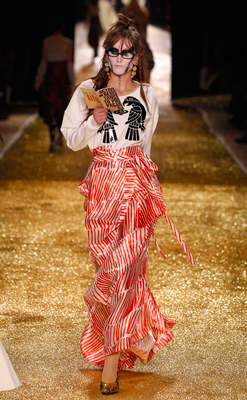

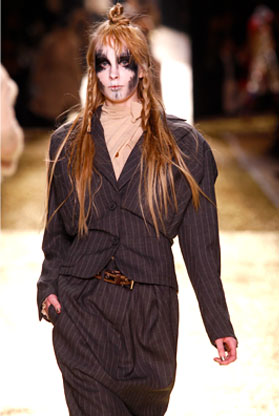

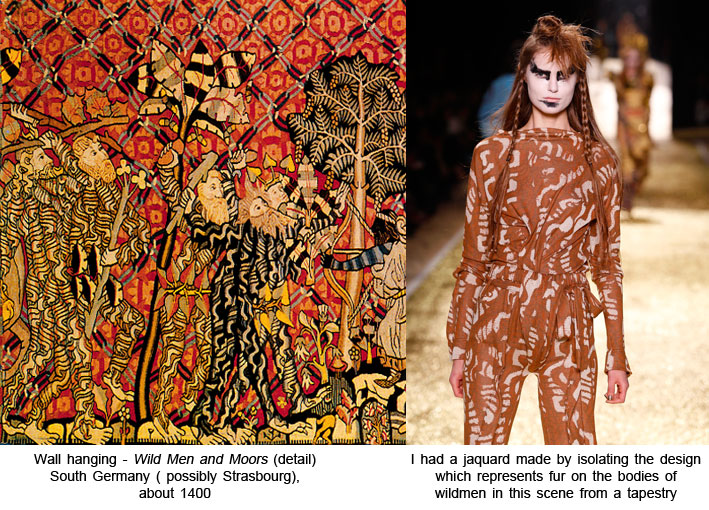
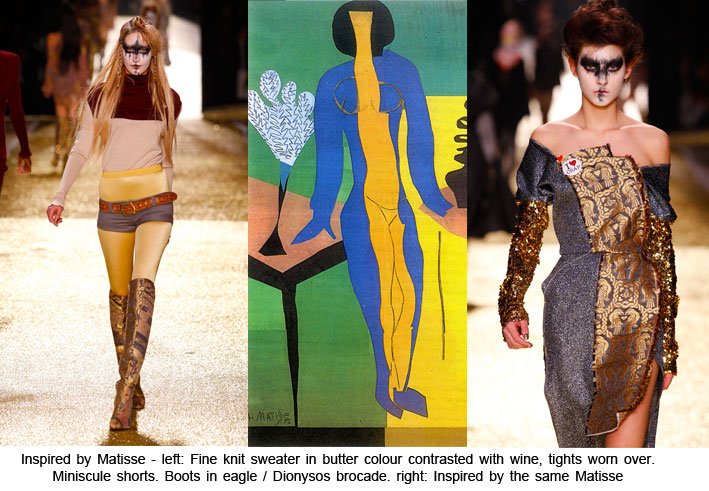
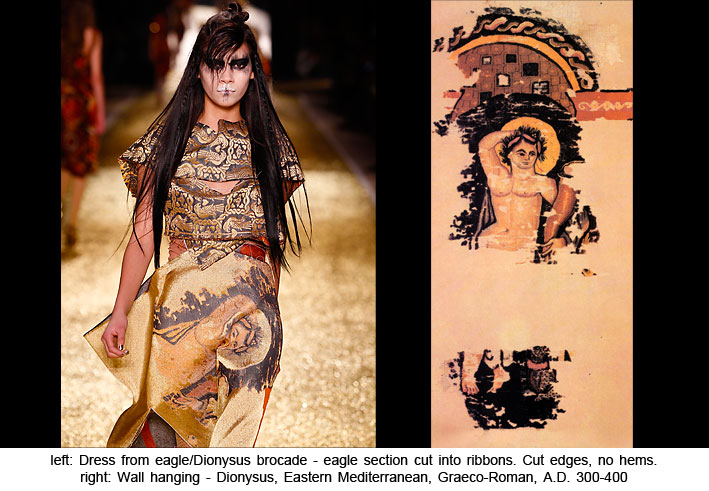
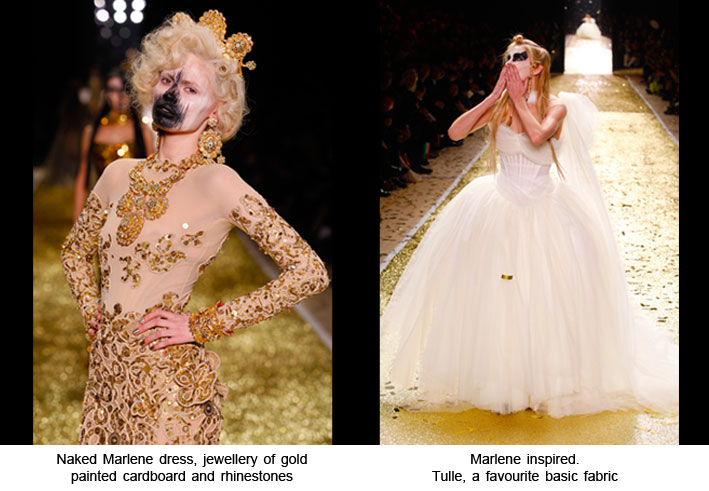


WOW! I always knew that a lot of work went into putting a collection together, but I never realised just how much!
I find the way that you used old fabrics and patterns to make something to fit for modern society fascinating. I love looking to the past in order to prepare for the future, and I believe that this is not only useful in fashion, but certainly as an Art Lover, and the idea that good art is timeless is represented here too. Great art never loses it’s greatness, and never will.
Loved the collection in general, but seeing the way you put it together and the thought process was absolutely fantastic, thank-you!
James
Comment by James Emmett on 15/03/2011 at 4:52 pm
Fantastic collection, Vivienne! Thank you so much for sharing the inspiration behind the pieces, as it gives so much meaning to the otherwise beautiful clothes. I always have comments and questions about your clothes when I wear them, and I do give people the background behind the pieces when I know it. One example is a men’s Gold Label sweater I have from several years ago done in the gold Boule print, and I always tell people who ask that this print was taken from a late 18th century French firescreen, so I feel I am helping to educate both myself and others through wearing your clothes. As you have said before, life is always better when you wear impressive clothes!
Thanks again,
Jeffrey Jordan
Comment by Jeffrey Jordan on 16/03/2011 at 4:40 pm
Thanks Vivienne for this insightful read. I love to read your views on all aspects of culture and life, but it was great to have a peek at how you create such wonderful clothes too. I particularly enjoyed this collection and it was a treat to see it for real in Paris. Thankyou! x
Comment by Lady Lloyd on 19/03/2011 at 6:12 pm
Fantastic, this will be very useful information for my daughter- 17 year old budding fashion designer xxx
Comment by Janine Calder on 21/03/2011 at 6:57 pm
Wow, it is a lot of work; just makes me love Vivienne Westwood so much more! I am so happy to get a little insight on how the collection was made. I love art and I enjoyed to see how you used it to create different prints. I love the “old” prints in this collection. I love the contrast of old and new, it is something I like to do as well.
-love
Comment by Ana Mercedes on 21/03/2011 at 7:15 pm
Thank you for this, Vivienne…what a joy to travel with you through the process. I would love to see you drape on a live model…a technique much favoured by Coco Chanel. I believe she made her models stand for hours on end! Sounds like you were much swifter, and kinder to your living mannequin. I would love to see more posts like this from you. You are an inspiration.
Comment by Liz O'Donovan on 22/03/2011 at 12:25 am
Dear Liz
Thank you for your post. If you’re interested in the experience of a living mannequin, please look out for the next blog: Creating World Wide Woman – Memoirs of a fitting model. I’m sure it will answer your questions and give you some insight into the process.
Comment by Vivienne on 22/03/2011 at 2:32 pm
Hi Vivienne,
I wanted to stop by and thank you for linking to our ‘zero waste’ site this week. I loved reading this post because of the sense of passion and energy that went into your collection. Even though we are doing quite different things with our work, passion and energy are the forces that drive my site forward too.
If you ever have the time or inclination I would love you to write a guest post for us. Many stores get bad press because they create ‘disposable fashion’ and I’m wondering how a designer can make a difference; perhaps with different cutting methods to create less fabric waste and the sheer fact that an ‘investment piece’ is not going to end up in landfill after a season.
If you’re interested, please email me and we’ll talk through some ideas.
Warm wishes
Rachelle (Mrs green)
Comment by Mrs Green @ my zero waste on 24/03/2011 at 9:10 am
Vivienne,
i wish to let you know how valuable and useful the information you shared is to me. I´ve graduated from fashion school in Buenos Aires not too long ago and you were and continue to be of great inspiration to me. I actually selfmade a dress out of an old discoloured jean-shirt, played around with its shape for a while and recreated a whole new piece, and i call it my vivienne shirt 🙂
its fascinating to read about the process and evolution of a collection, from a long time designer like you. Thanks again for being so kind to share it. Internet is such a blessing, how could i ever imagine we could be one “post” away? Unbelievable!
I will continue to read you blog, while trying to get a life…
With all my respect and care,
Jannine
Comment by Jannine Frend on 29/03/2011 at 11:27 pm
Dame Vivienne,
You are an inspiration as are your collections. It’s amazing to see how much hard work and thought you put into your collections.
I am getting a life and love your blog
Comment by Scott Russell on 01/04/2011 at 7:13 pm
Dear Vivienne. Thank you from all my heart!
Your open and honest way of describing the process of awakening a collection from the channels ideas travel through, into manifestations of matter, beautiful pieces of art, leaves me totally speechless. Your total absence of self-importance and transparency witnesses the soul of a true teacher, especially in our industry!
I completely love your implementation of great historic artworks. I am totally in love with the collection that is fully equivalent as great works of art on same level as the artwork that inspired them.
I also love your many little clues, that among others reveal insights to upcoming designers on how designs must be also possible to realize for later production.
For many years I have been looking for a mentor, a giant in our industry. One who combines real human values with fabric and fashion in a way that includes also giving back to nature and with a playful, limitless approach to silhouettes and design. One who’s focus is broader that the width of a roll of fabric, whose heart is bigger than her wallet and whose eyes can catch longer visions than the next review. Being very fussy it has not been easy. I think though I have found her now in you Mrs.Westwood.
You are the only one, the only one in our industry I have ever heard stating that we should all buy less clothes, less but better and wear them more often. And this with a sincere hope that we will really listen. I think you are ahead of the current paradigm predicting the future exactly as it will become.
I am a self-taught designer and have worked with design, manufacturing, and retail since the end of the nineties. Now I work with design and have an agency bureau representing high profile designers.
You are such an inspiration. I would give anything to work for and with you. I guess I am in a very long cue here.
Surely you have and agent or distribution here I Denmark already. If you dont, it will be my honour and privilege to represent your lines to unique stores and department stores here my country!
David Starr Jordan said; The world stands aside to let anyone pass who knows where she’s going. You certainly knew Mrs. Westwood!
Thank you again!
Sincerely Maria
Comment by Maria on 08/05/2011 at 2:03 am
Thank you Mrs. Westwood for inspiration/visions & everything
Comment by Lucia on 08/11/2011 at 6:14 pm
Hi,I’ve been a participant around your blog for a few months. I love this article and your entire site! Looking forward to reading more!
Comment by Jonah on 21/09/2012 at 4:57 am